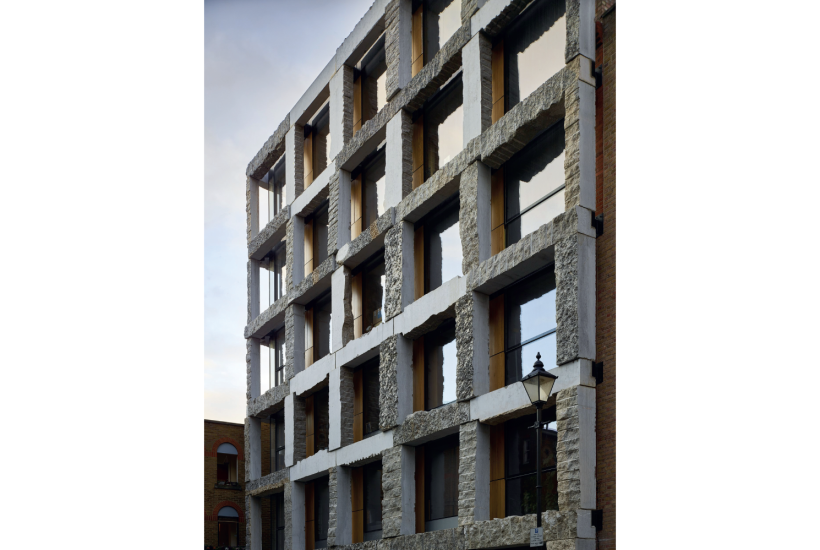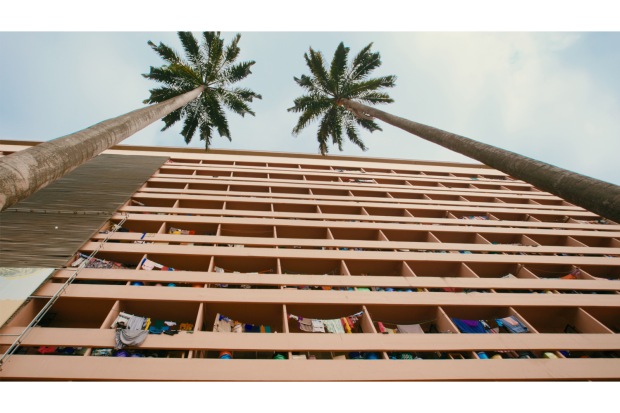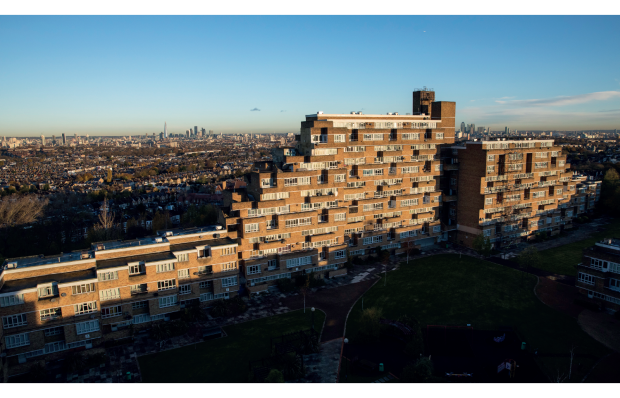The story of ‘The Three Little Pigs’ is hammered into us all from an early age. But its moral lessons obscure its more literal advice about building: skimping on materials is a false economy. It’s a lesson learned too late for schools built with reinforced autoclaved aerated concrete (Raac). Who would’ve predicted that concrete made cheaper by cutting it with air, puffed up like a Malteser, would end up crumbling like one too? It’ll soon prove that the initial cost savings of Raac will be wiped out multiple times over once the risk to life and expensive, disruptive repairs have been taken into account. Getting materials wrong almost cost the little pigs their bacon. Is it any surprise that we are returning to building in solid, dependable masonry?
While we build extensively in brick, tarting up mediocre developments in a half-hearted response to local context, stone masonry doesn’t require multiple mines for its ingredients, or energy and emissions-intensive firing; stone is simply quarried and cut to size, at a fraction of the environmental impact of brick, let alone that of concrete. For a construction industry charged with causing 40 per cent of the UK’s carbon emissions, stone seems to be a no-brainer, lying readily beneath our feet.
I speak with the architect Amin Taha, who, along with his engineer collaborator Steve Webb, is among the leading evangelists for stone, and has been making the environmental case for using it as a load-bearing material. We meet at 15 Clerkenwell Close in London, the building that is his home, the office of his architectural practice Groupwork and his manifesto for stone architecture. Five years after its completion, it has settled in gracefully, with creeping vines colonising its façade. And what a façade – among drab offices and flats, Amin’s building retains its original, elemental radicalism: limestone blocks stacked into a grid of beams and posts, with the satisfying solidity of a megalithic structure. There is no mistaking this stone for some effete decorative veneer; it holds up the building, just as it did for the long-lost limestone Augustinian abbey that once stood here.
Before we even start our conversation, Amin puts me to work, handing me a stone block to hammer open a crate of samples just arrived from a quarry in Spain. There is a garden next to the building, and Amin has been filling it up with bits of stone, gradually turning it into a sample library for architects eager to learn more about using the material.
Perhaps that learning is sorely needed. ‘Architects, and I’m no exception, are pretty badly educated about materials and their cultural and architectural history,’ Amin laments. He pins the blame on a moment in the 1790s when architects reinvented themselves as a gentlemanly profession. Eager to distance themselves from tradesmen, they abandoned tectonic, hands-on learning. Stonemasons’ apprenticeships were out. Instead ‘we’re just going to learn how to draw; preferably the classical orders, preferably Greek.’ The preoccupation with drawing still survives in architectural education today.
I ask if the fallen, half-carved Ionic column in front of the building references this. In fact, it’s one of multiple inside jokes, one of which refers to architects’ fetishisation of stone ruins, such as how Joseph Gandy’s paintings depicted John Soane’s then-unbuilt buildings as ruins-to-be. ‘They were saying: your ruins will be like the Romans’, they’ll be the legacy of a great empire.’
Does he think stone is still tinged with conservative or even imperial connotations? ‘For some, stone was inseparable from edifices that represented attitudes that led to war. After two world wars, they wanted to sweep aside that past and embrace the new.’ In the heady haze of technology’s ‘white heat’, was Raac one embrace too far? ‘We all experiment in life, and we make errors.’ At least with stone construction we can rely on an experimental record dating literally back to the Stone Age.
For Amin, stone’s cultural baggage is trivial. ‘It doesn’t and shouldn’t have any political connotation. We can cut it out and do what we want: classical details, gothic revival, or something more contemporary.’ When viewing Amin’s building – a raw expression of how that stone is split and sawn according to the quarry master’s judgment – alongside the Portland stone classical pediments of St James’s Church across the road, it’s solid proof of the neutrality of stone in the culture war of architectural styles.
Embracing materials of progress – steel, concrete, glass – also meant losing quarries and skills passed down generations; stone now costs more than it should. But Amin can already see demand for its eco-credentials turning the tide. So why aren’t architects just using it? Amin traces the problem back to the same root: ‘We’ve trained architects to draw beautiful façades, effectively a piece of wallpaper that is tacked on to the structure.’ Design stages, planning, consultants and even fees are structured in a way that treats materials as interchangeable annotations on drawings rather than entirely different ways of building. Structural stone construction requires architects to go that extra mile.
Planners, too, quite literally had a bone to pick with the location of naturally occurring fossils in Amin’s limestone façade. I ask if the planning system, forged in post-war years around mass-produced building ‘products’, is a barrier for materials with natural variations. He agrees. Those in power would do well to remember that buildings deemed ‘officially beautiful’ by various housing ministers, such as the limestone Royal Crescent in Bath, were accomplished without overbearing planners.
While Amin’s building narrowly escaped its trumped-up demolition order from Islington Council in 2019, it will eventually reach the end of its life. But not so for the limestones from which it is built. Stone’s longevity and reusability is ancient wisdom: think about how bits of Roman column were reused as spolia in Renaissance Italian walls, or the importance of the ‘stone robbing’ of Norman castles to create places like Castle Combe. Why bother quarrying when you can use stone that’s already cut and carved?
It’s yet another traditional building practice being revived for sustainability reasons, further diluting stone’s environmental impact across multiple lives. I speak to Juliet Haysom, an artist and educator at the Architectural Association. Juliet’s brother Mark runs the family business, a quarry and masonry works, source of Purbeck-Portland stone, which has engaged 11 generations of Haysoms.
Juliet, with Aude-Line Dulière, was behind Placeholders at the London Design Festival 2021. As part of the controversial V&A extension by Amanda Levete Architects, the Aston Webb screen on Exhibition Road was opened up, and the fine Portland stone ashlars removed and left to languish in storage. These were rescued from being crushed into gravel by Mark’s business, who relocated the stones to his quarry in Dorset. The opportunity came for their return when Juliet and Aude-Line proposed reassembling the stones into street furniture outside the V&A.
Kensington and Chelsea council set out to spend about £1.25 million on ‘hostile vehicle mitigation’ measures on Exhibition Road, commissioning solid granite benches quarried in India, tooled in Italy, before being shipped to London. It’s perverse when stones that had come from that very road were ready to be used. When the Suez Canal obstruction delayed the new granite, through serendipity and Juliet and Aude-Line’s negotiations, Placeholders filled the gap.
I can’t see how new (probably machine-milled) granite can compare with the patina of age: the ashlars embody hours of Edwardian stonemasons’ skilled labour. They also bear witness to more than a century of London’s history: ‘That wall had retained the evidence of two incendiary bombs from WW2, with some stones having shrapnel patterns,’ says Juliet. Like in Venice’s patere – marble reliefs from the Byzantine mainland reused as wall decorations – repurposing stones is not just economical, but a material reminder of places, buildings and lives past.
It’s no surprise that our bureaucracies are a barrier here too. ‘Rather than requiring complete standardisation before permitting reuse, we need to trust the connoisseurship of those who work with stone,’ says Juliet. ‘There’s so much embedded expertise. How some stone is cut vertically or horizontally affects its appearance and strength. There’s skill needed to identify stone, which varies in properties within the same bed. It’s not a handbook or colour chart you can follow.’ As recent years have shown, building regulations themselves are far from infallible. Perhaps there’s deeper knowledge in a stonemason’s intuition we’ve yet to unearth.
As I scroll idly on Instagram, I notice one of Charlie Gee’s posts, a 20-year-old stonemason who has amassed half a million followers with videos flaunting his chiselwork and his chiselled physique. It seems this connoisseurship extends to sex appeal. If even Gen Z can rediscover this traditional material’s allure, then its comeback might as well be set in stone.
Got something to add? Join the discussion and comment below.
Get 10 issues for just $10
Subscribe to The Spectator Australia today for the next 10 magazine issues, plus full online access, for just $10.
You might disagree with half of it, but you’ll enjoy reading all of it. Try your first month for free, then just $2 a week for the remainder of your first year.














Comments
Don't miss out
Join the conversation with other Spectator Australia readers. Subscribe to leave a comment.
SUBSCRIBEAlready a subscriber? Log in